Module 5—Circular Motion
 Read
Read
Read pages 248 to 250 of the textbook, starting at “Circular Motion and Newton’s Laws." Look for the new terms to describe the speed of rotation.
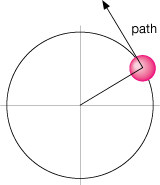
The speed of rotation is usually measured by the time it takes for one revolution or cycle, called the period (T), or by the frequency (f) of revolutions or cycles in a time period. Frequency may be expressed as rpm (revolutions per minute) or in the SI units of hertz (Hz).
1 Hz = 1 cycle/s
![]()
period: the time for one complete cycle (T)
frequency: the number of cycles in a time period (f)
 Self-Check
Self-Check
SC 9. Complete question 3 of the “Practice Problems” on page 250 of the textbook.
 Self-Check Answers
Self-Check Answers
SC 9.
Given
rotation rate = 6.0 × 104 rpm
Required
the frequency (f ) and period (T )
Analysis and Solution
Convert the rotation rate to frequency in hertz using a dimensional analysis ratio, and then convert the frequency to period.
![]()
This is a frequency of 1.0 × 103 Hz because a cycle per second is a hertz.
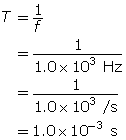
Paraphrase
The frequency of rotation of the centrifuge is 1.0 × 103 Hz, and the period of rotation is 1.0 × 10–3 s.
 Read
Read
Normally we think of speed in terms of km/h or m/s. How do frequency in Hz and period (T) relate to that? Read pages 250 and 251 of the textbook, starting at “Speed and Circular Motion," to learn how to convert from one to the other.
 Self-Check
Self-Check
SC 10. Complete question 1 of the “Practice Problems” on page 251 of the textbook.
 Self-Check Answers
Self-Check Answers
SC 10.
Given
v = 261.0 km/h r = 0.350 m
Required
the period (T)
Analysis and Solution
Convert the speed to m/s, and then rearrange the formula ![]() to solve for the period. Substitute in the values and find the answer.
to solve for the period. Substitute in the values and find the answer.
![]()
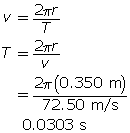
Paraphrase
The period of rotation of the tire is 0.0303 s.
 Read
Read
What about acceleration and force? How do they apply to circular motion? Read pages 252 to 255 of the textbook to see how acceleration is handled in these situations.
 Self-Check
Self-Check
SC 11. Complete question 1 of the “Practice Problems” on page 255 of your textbook.
 Self-Check Answers
Self-Check Answers
SC 11.
Given
diameter = 28.0 cm
T = 0.110 s
Required
the centripetal acceleration (ac)
Analysis and Solution
The magnitude of the acceleration can be calculated using the formula ![]() . The direction of centripetal acceleration is always towards the axis of rotation.
. The direction of centripetal acceleration is always towards the axis of rotation.
The radius is half the diameter, so r = ![]() 0.140 m.
0.140 m.
Determine the speed of the outermost edge of the Frisbee:

Use this value to calculate the centripetal acceleration:
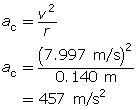
Paraphrase
The centripetal acceleration of the outer edge of the Frisbee is 457 m/s2 directed towards the centre of the Frisbee.
 Read
Read
In the simulation Circular Motion: Horizontal, which used the ball and string earlier in the lesson, the force was just given in the data. How is force calculated for circular motion? Read page 256 of the textbook to see how force is determined in circular motion.
 Self-Check
Self-Check
SC 12. Complete question 2 of the “Practice Problems” on page 256 of your textbook.
 Self-Check Answers
Self-Check Answers
SC 12.
Given
m = 0.0021 kg
r = 23.0 cm
Fc = 0.660 N
Required
the speed of the wheel (v)
Analysis and Solution
Rearrange the centripetal force formula to find the speed.
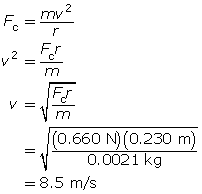
Paraphrase
The speed of the wheel is 8.5 m/s.
Newton’s laws can be applied to many different situations where circular motion is common, such as travelling in a vehicle. In such cases, there are many different forces that can be directed inward. For a car rounding a curve, it is the friction between the road and the tires that is directed inward. On a carnival ride, the inward force is tension in the structure (similar to that of a ball and string). Explore the nature and types of forces that cause circular motion by completing the Horizontal Circular Motion: Forces tutorial.
 Self-Check
Self-Check
SC 13. Suppose you were to triple the speed with which you twirled a ball on a string. How would that affect the size of the inward force (tension) in the string?
 Self-Check Answers
Self-Check Answers
SC 13.
The centripetal force is proportional to the square of the speed:
![]()
If you triple the speed, you increase the centripetal force needed, the tension in the string, by 32 or nine times:
![]()
The inward force would increase by a factor of 9.
 Module 5: Lesson 1 Assignment
Module 5: Lesson 1 Assignment
Remember to submit the answers to TR 2 and TR 3 to your teacher as part of your Module 5: Lesson 1 Assignment.
 Try This
Try This
TR 2. Suppose you were to reduce the radius of the arc through which you twirled a ball on a string by one-half. How would that affect the size of the inward force (tension) in the string?
TR 3. Suppose you were to increase the mass of the ball by five times. How would that affect the size of the inward force (tension) in the string?
 Self-Check
Self-Check
SC 14. Complete question 2 of "5.1 Check and Reflect" on page 247 of the textbook.
 Self-Check Answers
Self-Check Answers
SC 14.
(a) friction
(b) tension in the rope
(c) gravitational force of Earth on the Moon
 Module 5: Lesson 1 Assignment
Module 5: Lesson 1 Assignment
Remember to submit the answer to TR 4 to your teacher as part of your Module 5: Lesson 1 Assignment.
 Try This
Try This
TR 4. Complete question 8 of “5.2 Check and Reflect” on page 268 of the textbook.
 Discuss
Discuss
Imagine you have a ball on the end of a rope and you whirl it in a horizontal circle at a steady speed. Does it feel like the ball is pulling on your hand, or does it feel like your hand is pulling on the ball? Or do two forces exist as an action-reaction pair in the case of Newton’s third law? If two forces exist, which force is the action and which is the reaction?
Confusion about these questions leads to a common misconception that circular motion is caused by a centrifugal force. The term centrifugal is based on the Latin terms centrum ("centre") and fugere (“to flee”), making this an outward force. In contrast, the term centripetal is based on the Latin terms centrum ("centre") and petere ("tend towards"), making this an inward force.
In the discussion forum, propose an answer to each of these two questions:
D 1. Which term, centripetal or centrifugal correctly describes the action force and, therefore, the real force that causes circular motion?
D 2. Explain why the term centrifugal is sometimes used to describe the cause of circular motion but does not represent a force that actually exists.